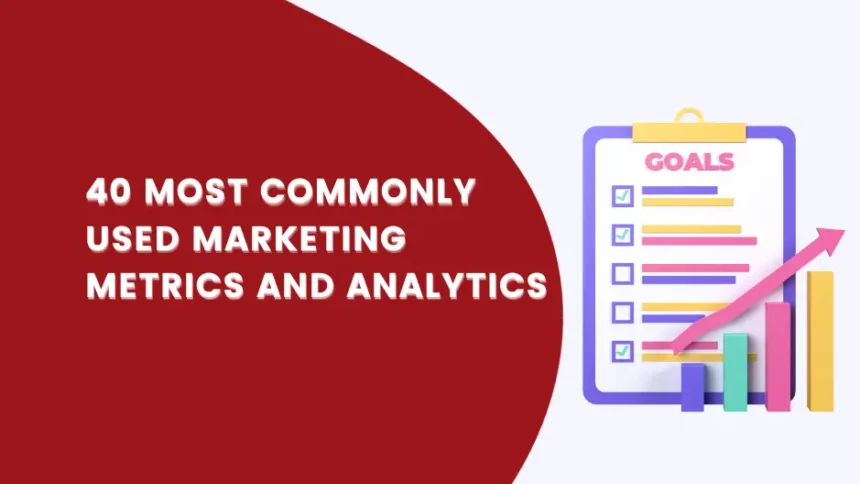In the ever-evolving landscape of digital marketing, staying ahead of the curve requires more than just creative campaigns and engaging content. Marketers need to make informed decisions backed by data, and that’s where marketing metrics and analytics come into play. In this comprehensive guide, we’ll dive deep into the world of marketing metrics, exploring their significance, types, and how to leverage them for improved strategies.
Here are some commonly used marketing metrics and analytics:
- Conversion Rate: This measures the percentage of visitors who take a desired action, such as making a purchase or signing up for a newsletter.
- Return on Investment (ROI): This metric calculates the revenue generated as a result of marketing efforts compared to the cost of those efforts.
- Customer Lifetime Value (CLTV): This metric estimates the total revenue a customer will generate throughout their relationship with your business.
- Click-Through Rate (CTR): This metric calculates the proportion of people who click on a particular link or ad compared to the total number of times it’s shown.
- Cost per Acquisition (CPA): This calculates the average cost of acquiring a new customer.
- Traffic Sources: Examining where your website traffic comes from can provide insights into which marketing channels are bringing in the most visitors and conversions.
- Customer Acquisition Cost (CAC): This metric measures the average cost of acquiring a new customer, taking into account all marketing and sales expenses.
- Bounce Rate: This measures the percentage of visitors who navigate away from your website after viewing only one page.
- Social Media Engagement: Tracking metrics such as likes, comments, shares, and follower growth can help you understand how well your social media efforts are performing.
- Email Marketing Metrics: Open rate, click-through rate, unsubscribe rate, and conversion rate are important metrics to gauge the effectiveness of your email campaigns.
- Customer Churn Rate: This metric measures the percentage of customers who stop using your product or service over a given period. It helps you evaluate customer retention and identify areas for improvement.
- Average Order Value (AOV): AOV measures the average amount of money spent by customers in a single transaction. Monitoring AOV can help you identify trends and optimize your pricing strategy.
- Customer Engagement: This encompasses metrics such as time spent on your website, number of pages viewed, and interactions with your content. It indicates how well you are captivating and retaining your audience.
- Social Media Reach: This metric measures the number of people who see your social media content. It provides insights into the impact and visibility of your brand on various platforms.
- Cost per Click (CPC): CPC measures the average cost you pay for each click on your online advertisements. It helps assess the efficiency and effectiveness of your paid marketing campaigns.
- Landing Page Conversion Rate: This metric calculates the percentage of visitors who complete a desired action on a specific landing page. It helps you gauge the performance of your landing page and optimize it for better conversions.
- Search Engine Rankings: Monitoring your website’s position in search engine results for relevant keywords allows you to assess your SEO efforts and identify areas for improvement.
- Email List Growth Rate: This measures the rate at which your email list is growing. Tracking this metric helps determine the success of your email list building strategies.
- Social Media Follower Growth: Evaluating the growth rate of your social media followers gives you an indication of the success and impact of your social media marketing efforts.
- Customer Satisfaction Score (CSAT): CSAT measures the satisfaction level of your customers after interacting with your brand. It helps you gauge the overall customer experience and identify areas for improvement.
- Customer Retention Rate: This metric measures the percentage of customers you have successfully retained within a given time frame. It sheds light on your ability to build loyalty and maintain lasting relationships with your audience.
- Mobile Conversion Rate: With mobile usage on the rise, tracking the conversion rate of visitors on mobile devices can help you optimize your mobile experience and capture more mobile customers.
- Referral Rate: This metric provides insight into the number of new customers acquired through word-of-mouth referrals. It demonstrates the effectiveness of your customer satisfaction and referral programs.
- Time to Conversion: This measures the amount of time it takes for a lead to become a customer. Understanding this metric can help you identify bottlenecks and streamline your sales process.
- Marketing Qualified Leads (MQLs): MQLs are potential customers who have shown interest in your products or services and are more likely to become customers. Tracking MQLs helps you assess the effectiveness of your lead generation efforts.
- Cost per Lead (CPL): This metric calculates the average cost spent on acquiring a lead. It aids in evaluating the efficiency and success of your lead generation campaigns.
- Customer Feedback and Reviews: Actively monitoring and analyzing customer feedback and reviews can provide invaluable insights into customer satisfaction, sentiment, and areas for improvement.
- Website Load Time: The speed at which your website loads is crucial for user experience and search engine rankings. Monitoring and optimizing website load time can improve user satisfaction and conversion rates.
- Social Media Share of Voice: This metric measures the visibility and presence of your brand in social media conversations compared to your competitors. It helps you understand your market share and identify new opportunities.
- Cost per Retention (CPR): CPR measures the average cost of retaining existing customers. Understanding this metric helps you allocate resources effectively and maximize customer value.
- Customer Acquisition Rate (CAR): CAR measures the speed at which your business is acquiring new customers. Keeping a close eye on this metric allows you to evaluate the effectiveness of your marketing and sales efforts.
- Customer Satisfaction Index (CSI): CSI measures the overall satisfaction level your customers have with your products or services. By understanding how satisfied your customers are, you can pinpoint areas for improvement and deliver exceptional experiences.
- Cost per Thousand (CPM): CPM estimates the cost of reaching one thousand potential customers with your advertising campaigns. It helps you assess the efficiency and cost-effectiveness of different marketing channels.
- Return on Ad Spend (ROAS): ROAS measures the revenue generated in relation to the amount spent on advertising campaigns. This metric helps you evaluate the profitability of your marketing investments.
- Organic Search Traffic: This metric tracks the number of visitors coming to your website through organic search results. It gives you insights into the effectiveness of your SEO strategies and the visibility of your brand.
- Customer Segmentation: Segmenting your customer base based on various criteria, such as demographics or purchase behavior, allows you to personalize your marketing efforts and improve targeting.
- Brand Awareness: Evaluating brand awareness helps you understand how well your brand is known and recognized by your target audience. It aids in measuring the effectiveness of your brand-building initiatives.
- Social Media Conversion Rate: This metric measures the percentage of social media followers or visitors who take a desired action, such as making a purchase or filling out a form. It helps you assess the effectiveness of your social media strategies.
- Customer Effort Score (CES): CES measures the ease with which your customers can interact with your brand, product, or service. Minimizing customer effort enhances satisfaction and loyalty.
- Marketing Qualified Account (MQA): MQA identifies potential customers or accounts that align with your ideal customer profile and are ready to engage with your sales team. It helps streamline your lead nurturing and sales efforts.
- Website traffic: This measures the number of visitors coming to a website over a specific time period and helps understand overall website performance.
- Time on page: This metric measures how long visitors spend on a specific web page. It provides insights into the engagement level of your content and the effectiveness of your website design.
Remember, the choice of metrics to track should align with your specific business goals and objectives. By monitoring and analyzing these metrics, you gain valuable insights that can drive growth and make data-driven decisions to maximize the performance of your marketing efforts.
Conclusion
In conclusion, tracking marketing metrics and analytics is imperative for businesses of all sizes. These metrics provide valuable insights that enable informed decision-making, drive growth, and maximize the ROI of marketing efforts. By monitoring metrics such as customer acquisition cost, return on advertising spend, conversion rate, and customer lifetime value, businesses can optimize their marketing strategies and allocate resources effectively.
Additionally, metrics like social media engagement, email open rate, and website traffic help gauge the effectiveness of digital marketing campaigns and indicate areas for improvement. Choosing the right metrics to track depends on specific business goals and objectives.






